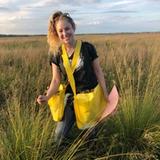When to grow new grass
Timing makes all the difference.
Cool-season grasses
Varieties such as fescues, bluegrass, and ryegrass thrive when seeded in temperatures between 55-75°F, typically in early fall or late spring.
Warm-season grasses
Grasses like Bermudagrass, Zoysiagrass, and St. Augustine are best planted at 70-90°F in late spring to mid-summer.
How to grow grass in 5 steps
Before you get started, measure your planting area. This will help you determine how much seed or plant material you'll need.
Pro Tip: Your custom lawn plan will tell you how big your lawn is!
Select your planting method
Before you grab that bag of seed, let's explore your options.
Seeding
The most versatile method, perfect for:
- Overseeding to thicken existing lawns
- Patch seeding bare spots
- Starting a brand new lawn
This method works especially well for cool-season grasses like bluegrass, fescue, and ryegrass.
Transplanting
For quick establishment, especially with warm-season grasses like St. Augustine and zoysiagrass, consider:
Sprigging: Small pieces of growing grass to fill gaps
Plugging: Mature grass seedlings for faster coverage
Sodding: Pre-grown grass sections for instant results
Sunday Tip:
While most warm-season grasses don't grow well from seed, bermudagrass is an exception—though not all varieties can be seeded.
Prep your planting site
Give your soil some love before planting:
- Hand-pull or spot-treat existing weeds
- Remove any debris off the lawn
- Mow slightly shorter than usual
- Rake away grass clippings
If needed: add a light layer of organic matter by topdressing or lightly aerating compacted lawn areas for optimum seed germination.
Select the right species
Choose grass that matches your:
- Local climate
- Sunlight conditions
- Traffic patterns
- Existing grass type (if any)
Not sure which grass is right for you? Try our Seed Finder Tool!
Plant your grass
For seeding, use a spreader at these rates:
Regular maintenance: 2 lbs./1000 sq. ft.
Heavy repair or new lawns:
- Fescue Rescue: 8 lbs./1000 sq. ft.
- Shade Select: 5 lbs./1000 sq. ft.
- Lucky Lawn: 5 lbs./1000 sq. ft.
- Pet Lawn: 8 lbs./1000 sq. ft.
- Kentucky’s Best 2 lb./1000 sq. ft.
- Bermuda Time: 1 lb./1000 sq. ft.
*For size reference: 1000 ft2 is about the size of a volleyball court
For transplanting methods:
- Sprigs: Place 5-10 bushels per 1,000 sq ft
- Plugs: Space 2+ inch plugs, 2-4 inches apart
- Sod: Calculate needs based on square footage
Water correctly
Watering correctly is the number one thing you can do to establish healthy grass.
Keep soil consistently moist until:
- Seeds: 60% germination achieved
- Transplants: Grass is firmly established
Adjust frequency based on your climate—more often in dry areas, less in humid regions.
Sunday Tip:
Once the seeds germinate or grass is established, you can reduce watering to a normal schedule.
How long does grass take to grow
Depending on weather conditions, light availability, watering, and other potential interruptions like pets or wildlife, it can take anywhere from a couple of weeks to a month or more for your grass to really start to fill in your lawn.
From seeds: Depends on grass species!
- Perennial rye: 3-7 days
- Fescues:: 6-12 days
- Bermudagrass: 7–21 days
- Kentucky bluegrass: up to 21 days
Transplants: Timing will vary depending on planting method and density.
- Sod: 1-4 weeks
- Plugs: 1+ months
- Sprigs: 2+ months
Ready to feed your new lawn? Get a custom Sunday plan tailored to your grass type and growing conditions.
Caring for your new grass
Once established, your new grass needs:
- Deep, infrequent watering
- Higher mowing height
- Regular grasscycling
- Good fertilization
Start mowing when grass reaches proper height or shows lateral growth. This encourages spreading and helps outcompete weeds.
Let's get growing
Our lawn engine uses satellite data to map out your lawn size and determine things like average rainfall, common weeds, and pest activity.
Cited sources
Quantification and Implications of Soil Losses from Commercial Sod Production. Soil Science Society of America Journal.












